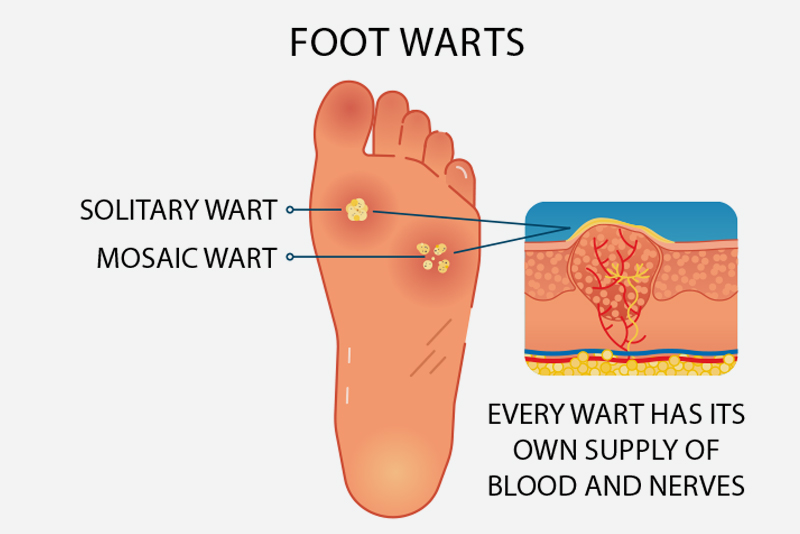Plantar warts grow on the soles of the feet and appear as small hardened lesions which are flattened out. They are caused by a virus called HPV – human papillomavirus – which enters the blood stream through small cuts in the soles of the feet. Plantar warts are not a serious health concern and are often mistaken for calluses or corns. They are generally small, about half a centimetre in diameter, but can grow larger over time.
Without medical treatment, 65% of common warts will go away on their own but this may take up to two years. As plantar warts are on the soles of the feet, they can cause discomfort and even intense foot pain. We recommend getting them attended to as soon as you can, especially in young children who quickly learn to compensate for pain and alter their gait accordingly. This can lead to other structural problems in their feet, legs and hips.
Symptoms of a plantar wart
- A hard, thickened or callus-like area of the skin which feels like it is growing inwards
- Rough lesions on the bottom of the foot around toes or the heel
- A circular spot with a black spot in the middle, which are commonly called wart seeds but are actually small, clotted blood vessels
- Discomfort or pain when walking or standing
Related article: Athlete’s Foot: Causes, Symptoms and Treatment
What increases the risks of developing a plantar wart?
There are precautions you can take to reduce the risk of developing a plantar wart which can develop gradually over several months.
- Walking barefoot around swimming pools – the virus lives in warm, wet areas so by remembering to wear your thongs, you’ll prevent contracting the virus
- Walking barefoot in public showers and locker rooms – same as above
- Feet that are wet or sweaty inside shoes – this provides an ideal breeding ground for the virus so keep your feet and toes dry and regularly place your shoes in the sun to dry and air them
- Scratching or picking at the wart which can spread the infection to other areas of the foot
- Plantar warts are more common in children and teenagers so check their feet if they complain about any discomfort or educate them on what to look out for
How we treat a plantar wart
At the clinic, we’ll assess the condition of the wart and help you understand what you need to do to reduce the likelihood of developing more. We may recommend or use any of the following treatments:
- A topical cream applied directly to the skin such as salicylic acid or lactic acid. It may take three months or more for the treatment to get rid of the warts with topical creams.
- Cryotherapy – the warts are frozen with liquid nitrogen.
- If the wart is persistent, we may suggest curettage and electrocautery – a surgical procedure performed under local anaesthesia by your doctor.
- Laser therapy – a laser is used to burn off the warts.
Call us to arrange an appointment with one of our podiatrists
If a Plantar Wart is recurring, pop into our podiatry clinics at Linden Park, Stirling or Mount Barker and we’ll suggest the most effective treatment to remove it and prevent it from recurring.
Especially for kids, we cannot stress enough the importance of getting plantar warts treated sooner than later. Plantar warts can quietly develop over months, and can be mildly uncomfortable and even go unnoticed. In the meantime they will impact a child’s natural gait and potentially cause other issues.
Call us at a convenient location near you to make an appointment with one of our podiatrists:
Sander Podiatry Adelaide – 08 8379 1456 (Greenhill Podiatry)
